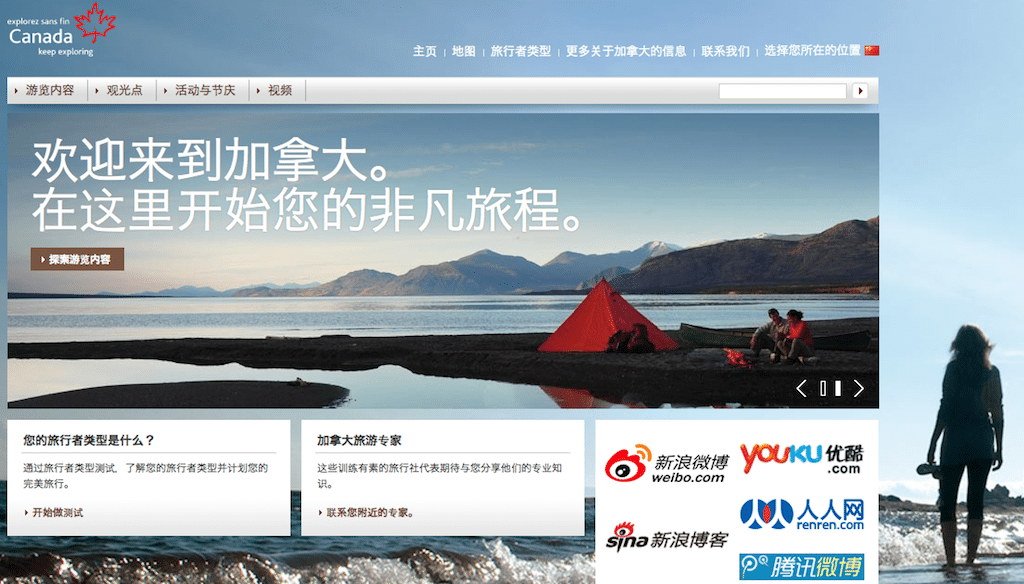Everyone Wants a Chinese Tourist in 2013: How 30+ Countries Plan to Lure Them In

Skift Take
A record 1 billion tourists crossed international borders in 2012, and Chinese travelers are becoming a bigger and bigger part of it. Outbound tourists rose from 16.6 million in 2002 to 70.3 million in 2011, and are expected to rise to 82 million this year, up 17 percent. Those numbers are expected to rise to a whopping 200 million by 2020, and the world needs to get ready to absorb that many extra tourists. And especially tourists spending money: UNWTO figures show that year on year, Chinese tourists spent 30 percent more when travelling abroad in 2012 than previous year.
From hotels, airports, malls and retailers hiring Manadarin speaking concierge services, to countries easing visa norms and doing joint marketing agreements with China, everyone wants the hordes of Chinese travelers spending money, especially the recession and debt crisis beset European and North American countries: U.S., UK and Australia are banking on Chinese visitors to shore up their sputtering economies.
Neighboring destinations like Hong Kong, Macau, Taiwan, Korea, Japan, Singpore, already very popular with Chinese, are re-architecting their tourism policies wholesale to accomodate these big numbers. Even countries like Gambia, Kazakhstan and Pakistan, not on any mainstream tourism map, are stepping up their marketing efforts to lure the mainland travelers.
If you’re in travel anywhere in the world and don’t have an evolved and nuanced China strategy, you aren’t a serious player in 2013.
What follows is a list of 32 countries that are actively strategizing and employing methods to increase Chinese visitor arrivals in 2013 to build a more lucrative tourism market:
Asia
Philippines: China is the fourth largest tourism market for the Philippines with more than 150,000 visitors arriving in the first six months of 2012. Many headed to Boracay Island, the most popular Philippine destination for Chinese tourists. The steady stream of Chinese visitors was briefly disrupted this summer during a territorial dispute, but picked up again by the fall. The Department of Tourism looks to attract additional Chinese tourists in 2013 by attending major travel fairs in China and offering ‘familiarization tours’ for travel agents and the media.
Malaysia: Malaysia increased flights from Guangzhou and Shanghai to the popular destination of Kota Kinabalu, which faces the South China Sea, to cater to the influx of Chinese tourists. Malaysian tourism minister expects its 1.5 million Chinese visitors outnumbered tourists from all other countries at the end of 2012.
Japan: Japan is one of the only countries that experienced a major decrease in Chinese tourists in recent months. The number of arrivals fell 33 percent year-over-year to 71,000 visitors following a territorial dispute over the Senkaku and Diaoyu Islands.
Thailand: Thailand received an extra boost of Chinese tourists in 2012 due to a territorial dispute between Japan and China that halted almost all tourism between the two countries. Current visitor numbers suggest that Chinese tourists will outnumber visitors from all other countries within the next five years; however, some critics say safety issues and language barriers thwart tourism growth in one of its most popular tourism destinations, Chiang Mai.
Nepal: Chinese tourism to Nepal has steadily increased since 2001, and the two countries recently signed a memorandum of understanding to collaboratively boost tourism. As part of the understanding, both sides have opened ports and resumed direct passenger transportation between Kathmandu, the capital of Nepal and Lhasa, the capital of Tibet Autonomous Region.
Indonesia: An increase in Chinese visitors to Bali this year made up for a decline in European tourists in Indonesia and made China the second biggest source of tourism after Australia. Indonesia aims to welcome 600,000 Chinese tourists in 2013, approximately 150,000 more than 2012.
Sri Lanka: Sri Lankan tourism officials push the government to pay attention to the importance of attracting Chinese tourists and suggest enhancing the country’s infrastructure to make the country better suited for increased tourism.
To that end, the Sri Lanka Tourism Promotion Bureau and SriLankan Airlines participated in Chinese travel shows and organized their own tourism road show throughout China in 2012. The shows gave tourism officials the opportunity to establish direct relationships with Chinese travel operators and media organizations.
Vietnam: More than 1.4 million Chinese tourists visited Vietnam in 2012, and the country is looking to increase that number by introducing shopping tours, promoting discounted airfares, and increasing engagement with large Chinese travel agencies. In addition to increasing visitor numbers, Vietnam is also strategizing how to extend Chinese visitors’ stays and increase their spending. Vietnam is working on a relaxed visa scheme with Laos, Thailand, Cambodia, and Mynamar to increase Chinese travel between all countries.
Cambodia: China is the third largest source of tourism for Cambodia with 234,440 visitors in the first nine months of 2012, up 32 percent compared with the same period last year.
Taiwan: Taiwan is the only country that wants fewer Chinese tourists. The country’s tourism bureau recently restricted the daily arrival of Chinese travelers to 4,000, although the average for daily arrivals is consistently over 5,000. The boom began in 2008 when Taiwan opened up its borders to Chinese tourists, but complaints that the multitude of Chinese travelers overwhelmed other sightseeing tourists prompted the tourism board to restrict the inbound flow.
North Korea: Even North Korea wants in on the action. DPRK is improving its infrastructure in hopes of increasing the number of incoming Chinese tourists, which has risen since China listed DPRK as a tourist destination country in 2010. The newly opened destination is attractive to travelers for its unspoilt destinations and because it is relatively cheap compared to other international destinations. DPRK has also simplified the visa procedure for Chinese tourists to attract more tourists.
India: India has felt little benefit from the increase in traveling Chinese tourists thus far, but hopes to change that in 2013. One strategy is to use the blockbuster success of the movie ‘Life of Pi’ in China and offer ‘Life of Pi’ tour packages in China, as well as make Chinese-speaking guides and Mandarin websites available.
Russia: The national tourism agencies of China and Russia signed a memorandum of understanding on investment and cooperation in the tourism sector. As part of the agreement, China hosted the “Year of Russian Tourism” in 2012 and Russia will host the “Year of Chinese Tourism” in 2013 to promote the exchange of tourism, culture, and education.
Oceania
New Zealand: China is the second biggest source of visitors for New Zealand and accounted for 8 percent of visitors in November 2012. The Chinese overtook UK tourists for the first time that month, but are still far fewer than the 45 percent of visitors that came from Australia. New Zealand went to lengths to produce a tourism video with young Chinese travelers renting a campervan to explore state parks independently.
Australia: Chinese tourists also surpassed the British to become the second-largest tourism market for Australia. In the 12 months prior to September 2012, Chinese arrivals grew by 17 percent. Anecdotal evidence provided by an Australian business suggests that accepting Chines UnionPay credit cards and hiring staff that speak a Chinese language substantially increases business in cities where Chinese airlines fly.
Western Australia has been putting major dollars behind its effort to attract Chinese travelers including a 4 million Australian dollar marketing campaign by Tourism Western Australia, China Southern Airlines and Tourism Australia to quadruple incoming Chinese visitors by 2020.
Europe
France: France is the most popular destination for Chinese tourists in Europe. Fine dining, luxury shopping, and a small town tied to the origins of the Chinese Communist party are to thank for that. France is also part of the Schengen visa scheme that gives Chinese travelers access to 25 countries with a single visa. France and Germany recently opened a joint visa application center in Beijing to further expedite the visa process.
Greece: Greece is looking to increase in Chinese tourists to aid its economic recovery. In order to attract more visitors than the approximately 80,000 that arrived in 2011, the debt-ridden country is working to ease the visa procedures for Chinese travelers, open direct flights between the two countries, and lower its VAT for food catering.
Czech Republic: Hotels and stores in Prague have begun to hire employees that Mandarin or Cantanese, or hire interpreters to have on call to communicate with Chinese tourists. Many retailers are also beginning to accept the Chinese bank card, UnionPay.
Denmark: The Danish government expects the number of incoming Chinese visitors to grow at an annual rate of 20 to 30 percent over the next few years. The number of nights that Chinese tourists stayed in Denmark grew 18 percent in the last year alone, possibly due to the launch of a direct flight between Shanghai and Copenhagen. The small European country is particularly popular with Chinese businesses looking to host meetings and conventions.
Britain: A record 149,000 Chinese visitors went to Britain last year, but it’s estimated that approximately 1.5 billion pounds a year are still lost from restrictions that limit incoming arrivals. To truly open the floodgates for incoming Chinese tourists like France and Italy, Britain would need to scrap its visa regulations that require Chinese tourists to apply and pay for a visa separate from the rest of Europe. The managing director of Harrods, which has more than 70 Mandarin-speaking staff members and more than 100 China Union Pay terminals, has urged Britain to further relax its visa system as Chinese visitors spend nearly double what other foreign tourists spend while on holiday in the UK.
Germany: Germany is well positioned to receive Chinese tourists as it’s included in Schengen visa scheme that gives the Chinese access to 25 countries in a single process. Tour companies and retailers find that speaking a Chinese language is a huge advantage to luring the travelers.
Cyprus: The European island country of Cyprus is working to attract 100,000 Chinese tourists in 2013. Its first step will be hosting Chinese tour operators from Hong Kong to familiarize them with the island. The island is also in talks to host the Miss Asia beauty pageant and the final episode of a popular Chinese TV series in hopes of visually introducing the island to the Chinese.
Middle East
Kazakhstan: Kazakhstan’s efforts to increase Chinese tourism is focused on the three-month World Expo set to take place in 2017, but also includes initiatives to develop transportation infrastructure, open direct flights to Chinese cities, and communicate tourism developments and projects with Chinese tourism officials.
United Arab Emirates: United Arab Emirates has seen incoming Chinese visitors increase by 50 percent between 2010 and 2011, a number that is expected to rise after the country was given “preferred destination status” by Beijing. UAE’s reputation for luxury and tax-free shopping makes it a popular destination for Chinese tourists. Shops and tour operators need only hire a Mandarin speaker and accept Chinese credit cards to fully enjoy the benefits of their location.
Pakistan: The majority of Chinese visitors traditionally visit Pakistan for business purposes, but the country is hoping to boost its leisure tourism image. It provides visa-on-arrival facilities for Chinese tourism groups and is working to promote its tourism products by participating in major tourism shows in Europe and Asia. The Pakistani tourism board also worked with a predominant Chinese television broadcaster to create a documentary on Pakistan and the Silk Route.
Africa
Kenya: A boom of Chinese tourism in East Africa is bypassing local Kenyan companies due their lack of knowledge on how to attract and engage with the Chinese. According to one Kenyan entrepreneur, the best way to begin engagement with Chinese tourists is hiring hotel staff that speak a Chinese language. Other tips to cater to Chinese guests include avoid giving rooms on the fourth floor for Chinese and offer green tea instead of coffee.
Egypt: Egyptian President Morsi met with tourism officials in Beijing this summer to strategize ways to increase outbound tourism to Egypt. Chinese tourists currently account for about 20 percent of Egypt’s incoming visitors and Egypt is looking to increase that number by increasing flights between the two countries and granting visa entry to Chinese tourist groups upon their arrival in Egypt.
Zimbabwe: Zimbabwe welcomed approximately 30,000 Chinese tourists in 2011, more than triple the number of Chinese visitors from five years ago. The country now aims for 50,000 Chinese arrivals by 2015. It sent a tourism delegation to participate in the largest professional travel mart in Asia, the China International Travel Mart (CITM), and set up a new visa application system that allowed tourists to apply online rather than travel to the embassy in Beijing.
South Africa: A record number of Chinese tourists (60,000) visited South Africa in the first half of 2012, a 68 percent growth over the first six months of 2011, thanks to the introduction of South African Airways’ direct flights between Johannesburg and Beijing. Chinese visitors numbers have been consistently increasing since 2009 when South Africa was granted approved destination status by China, and have been further bolstered by the opening of two new visa applications centers in China in 2011 and a South African travel promotion campaign specifically targeting Chinese visitors.
Americas
United States of America: The number of arriving Chinese tourists increased by 30 percent in 2012 due to the government’s expedited visa process. The most visited cities are major American hubs including D.C., New York, and Los Angeles where Universal Studios provides Mandarin-speaking employees.
Canada: Canada’s inbound tourism numbers were relatively flat in 2012 with fewer visitors coming from Europe and the US. The exception was an increase in incoming tourists from Asia, especially mainland China. Chinese tourists made 115,200 trips to Canada in the first five months of 2012, a 22.9 percent year-over-year increase.
Arrivals from Chinese tourists first took off in 2010 after Canada was given “approved destination status” by the Chinese government and the Winter Games put Vancouver on the map. The Canadian Tourism Commission is now looking to push its recent viral tourism ad across social media channels in Asia. It’s also created a Mandarin version of its tourism website.
Costa Rica: Costa Rica’s second largest trade partner is China, but has yet to tap into its lucrative outbound tourism market. The Central American country is looking to take advantage of its diplomatic bond established with China in 2007 by positioning itself as the entrance to Latin America. Costa Rica is working to ease visa regulations for businesses, encourage tourism-related businesses to use Chinese languages, and open direct flights between the two countries.
Peru: Peru received fewer incoming Chinese tourists than its South American neighbors in recent years, but is looking to change that by easing visa procedures for Chinese visitors, promoting health tourism, and participating in international travel shows.




